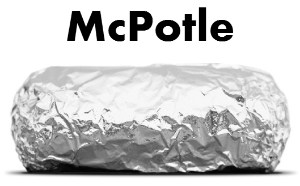 If you work for a broadcast radio company and you’re planning to organize a strategy meeting on the subject of extending your local brands online — as so many do — let me suggest you have it catered by McDonald’s Gourmet Burritos, perhaps accompanied by a refreshing six-pack of 7up Cola or Coca-Cola Spring Water.
If you work for a broadcast radio company and you’re planning to organize a strategy meeting on the subject of extending your local brands online — as so many do — let me suggest you have it catered by McDonald’s Gourmet Burritos, perhaps accompanied by a refreshing six-pack of 7up Cola or Coca-Cola Spring Water.
Except, of course, that those brands of food and drink don’t exist.
When McDonald’s saw that there was a market for a high-end burrito chain, they didn’t try to extend the “McDonald’s” brand into that product category.
Instead, the McDonald’s organization created (or acquired) a new brand name, Chipotle, and created a completely different product appropriate for that category — i.e., with a food prep line right in front of the customers, locally-sourced and organic ingredients, and elegant graphics and interior design).
Similarly, when Coke management saw an increasing interest among consumers in bottled water, they could have tried extending the “Coca-Cola” line into that product category, but they didn’t.
Instead, The Coca-Cola Company built (or acquired) a new brand name, Dasani, appropriate to that field. (This is also why we drink Simply Orange orange juice, not Coke OJ.)
When it comes to online radio, the vast majority of America’s top radio groups see one opportunity: “We want to extend our local brands online.” But I’m not sure that’s the biggest or the best opportunity to pursue.
There have been about fourteen years of experimentation in this area — and I’ve been involved in several of those experiments — and I believe it would be fair to say they’ve had about a zero percent success to date.
Sure, you could take your “Mix 108” FM brand and extend it online by adding a “Mix 108 New Music Channel” and a “Mix 108 Deep Cuts” channel and a “Mix 109 Eighties Hits” channel. But that is, I believe we are learning, not a very compelling approach in terms of consumer appeal. (However, I should note that most of these experiments that I’m aware of have been about creating side channels covering *niches*, rather than a personalizable online version of the main format. Regarding the latter, I think the jury’s still out — we still don’t know if that might work or not.)
To switch examples to the on-demand TV show world, I believe that NBC, ABC, and Fox got it right by creating a new brand for on-demand video called Hulu. True, it’s largely the same content as on broadcast, but it least it’s presented differently, as a purpose-specific brand loaded with additional content too. Similarly, Clear Channel’s I Heart Radio’s content may be largely its local AM/FM stations, but it’s freshly-presented.
In contrast, newspaper companies aren’t even trying. Even though any one of them could create a “USA Today”-type product that could be marketed and distributed online nationally or globally, I believe none has.
On the third hand, I seem to recall from my childhood that 7up, seeing new opportunities in the cola category, did launch a cola product called 7up Gold. In other words, they tried to extend their lemon-line brand into the cola category.
Order a case for your next strategy meeting — it should be a good reminder for you that extensions (as opposed to fresh new brands) may not necessarily be the way to go!

Fantastic insight Kurt! Thanks for this.